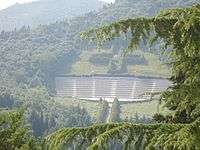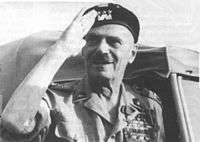Władysław Anders
| General Władysław Anders | |
|---|---|
 | |
| Born |
11 August 1892 Krośniewice-Błonie, Kingdom of Poland, Russian Empire |
| Died |
12 May 1970 (aged 77) London, England |
| Years of service | 1913–1946 |
| Rank |
Lieutenant General (Polish: Generał Broni) |
| Battles/wars |
World War I Polish-Bolshevik War World War II • Invasion of Poland • Monte Cassino |
| Awards | See list below |
| Spouse(s) |
1st Irena Maria Anders (Jordan-Krąkowska) 2nd Irena Anders |
| Relations |
Tadeusz Anders Karol Anders |


Władysław Albert Anders (11 August 1892 – 12 May 1970) was a General in the Polish Army and later in life a politician and prominent member of the Polish government-in-exile in London.
Biography
Before World War 2
Anders was born on 11 August 1892 to his father Albert Anders and mother Elizabeth (maiden name Tauchert)[1] in the village of Krośniewice–Błonie, sixty miles west of Warsaw, in what was then a part of the Russian Empire. At the time of his birth Poland did not exist as an independent state, as a result of the Partitions of Poland at the end of the eighteenth century.
Both his parents were of Baltic-German origin and he was baptised as a member of the Protestant Evangelical-Augsburg Church in Poland.[2] Anders had three brothers - Karol, Tadeusz and Jerzy, all of whom also went on to pursue careers in the military.[3] Anders attended a technical high school in Warsaw and later studied at Riga Technical University, where he became a member of the Polish student fraternity Arkonia.[4] After graduation Anders was accepted into the Russian Military School for reserve officers. As a young officer, he served in the 1st Krechowiecki Lancers Regiment of the Imperial Russian Army during World War I.[5]
When Poland regained independence in November 1918 he joined the newly created Polish Army. During the Polish–Soviet War he commanded the 15th Poznań Uhlans Regiment and was awarded the Silver Cross of the Virtuti Militari. After the war Anders continued his military education in France at the Ecole Superieur de Guerre and upon graduation he returned to Poland, where he served on the general staff of the Polish Army under General Tadeusz Jordan-Rozwadowski.
Anders opposed Józef Piłsudski's coup d'etat in Poland in 1926 but unlike Jordan-Rozwadowski, he avoided persecution by the Sanation regime that assumed power after the coup. Piłsudski made him the commander of a cavalry brigade in 1931 and he was promoted to the rank of general three years later.[6]
World War 2
Anders commanded the Nowogródzka Cavalry Brigade during the invasion of Poland in September 1939 and was immediately called into action, taking part in the Battle of Mława. After the collapse of the Polish Northern Front the brigade withdrew towards Warsaw, and also fought heavy battles against the Germans around Minsk Mazowiecki and in the second phase of the Battle of Tomaszów Lubelski. After learning about the Soviet invasion of Poland, Anders retreated south in the direction of Lviv (then Lwów), hoping to reach the Hungarian or Rumanian border, but was intercepted by Soviet forces and captured on 29 September, after being wounded twice.[7]
He was initially jailed in Lwów and subsequently transferred to the Lubyanka prison in Moscow on 29 February 1940. During his imprisonment Anders was interrogated, tortured and unsuccessfully urged to join the Red Army.[8]

After the launch of Operation Barbarossa and the signing of the Sikorski-Maisky agreement, Anders was released by the Soviets with the aim of forming a Polish Army to fight against the Germans alongside the Red Army. Continued friction with the Soviets over political issues as well as shortages of weapons, food and clothing, led to the eventual exodus of Anders' men – known as the Anders Army – together with a sizeable contingent of Polish civilians who had been deported to the USSR from Soviet-occupied Poland, via the Persian Corridor into Iran, Iraq and Palestine. Here, Anders formed and led the 2nd Polish Corps, while continuing to agitate for the release of Polish nationals still in the Soviet Union.
The 2nd Polish Corps became a major tactical and operational unit of the Polish Armed Forces in the West. Anders commanded the Corps throughout the Italian Campaign, capturing Monte Cassino on 18 May 1944.
After World War 2
After the war the Soviet-installed communist government of Poland deprived him of Polish citizenship and of his military rank. Anders had, however, always been unwilling to return to a Soviet-dominated Poland where he probably would have been jailed and possibly executed, and remained in Britain. He was prominent in the Polish Government in Exile in London and became inspector-general of the Polish forces-in-exile, as well as working on behalf of various charities and welfare organisations.
His book about his experiences during the Second World War, An Army in Exile, was first published by MacMillan & Co, London, in 1949.
He died in London on 12 May 1970, where his body lay in state at the church of Andrzej Bobola, and many of his former soldiers and their families came to pay their last respects. He was buried, in accordance with his wishes, amongst his fallen soldiers from the 2nd Polish Corps at the Polish War Cemetery at Monte Cassino in Italy.
After the collapse of communist rule in Poland in 1989, his citizenship and military rank were posthumously reinstated.
Many personal effects which once belonged to Anders are on display in the Polish Institute and Sikorski Museum in London.
Private life
Anders was married twice. He had two children with his first wife Irena Maria Jordan-Krąkowska (born 1894, died 1981) - a daughter, Anna (born 1919, died 2006) and a son, George (born 1927, died 1983).[9]
In 1948 he married the actress and singer Irena Jarosiewicz, better known under her stage name Renata Bogdańska, with whom he had a daughter, Anna Maria (born in 1950).
Medals
.jpg)
.jpg)
.jpg)
Anders received numerous awards and decorations:[10]
Poland
 Order of the White Eagle (awarded posthumously on 11 November 1995 by Lech Walesa)
Order of the White Eagle (awarded posthumously on 11 November 1995 by Lech Walesa)- Virtuti Militari
-
 Commander's Cross (2nd class)
Commander's Cross (2nd class) -
 Knight's Cross (3rd class)
Knight's Cross (3rd class) -
 Golden Cross (4th class)
Golden Cross (4th class) -
 Silver Cross (5th class)
Silver Cross (5th class)
-
- Order of Polonia Restituta
-
 Commander's Cross (3rd class)
Commander's Cross (3rd class) -
 Officer's Cross (4th class)
Officer's Cross (4th class)
-
-
 Cross of Independence
Cross of Independence -
Cross of Valour (four times: Polish-Soviet War (3) & Invasion of Poland)
-
 Gold Cross of Merit with Swords (four times)
Gold Cross of Merit with Swords (four times) -
 Army Medal (four times)
Army Medal (four times) -
 Commemorative Medal for War 1918-1921
Commemorative Medal for War 1918-1921 -
 Medal of the 10th Anniversary of Independence
Medal of the 10th Anniversary of Independence - Medal of 3rd May
- Medal for Long Service
-
 Silver (20 years)
Silver (20 years) -
 Bronze (10 years)
Bronze (10 years)
-
-
 Home Army Cross
Home Army Cross -
 Monte Cassino Commemorative Cross
Monte Cassino Commemorative Cross - Wound Decoration, (eight times)
Foreign
- Czechoslovakia
- France
-
 Commander of the Legion d'Honneur
Commander of the Legion d'Honneur -
 Croix de Guerre avec Palme
Croix de Guerre avec Palme -
 Médaille Interalliée de la Victoire 1914–1918
Médaille Interalliée de la Victoire 1914–1918
- Italy
- Grand Cross of Merit
-
._Medal.gif) Order of Homayoun (1st class)
Order of Homayoun (1st class)
- Imperial Russia
-
 Order of St. George (4th class, 1915)
Order of St. George (4th class, 1915) -
.png) Order of St. Vladimir with Swords (4th class, 1915)
Order of St. Vladimir with Swords (4th class, 1915) -
Order of St. Anna with Swords (2nd, 3rd (1918) and 4th class)
-
Order of Saint Stanislas with Swords (2nd and 3rd classes, 1918)
- United Kingdom
- United States of America
-
 Commander of the Legion of Merit
Commander of the Legion of Merit - Order of Lafayette
-
 Commander of the Order of St. Sava
Commander of the Order of St. Sava
See also
- List of Poles
- Anders Army
- Polish Armed Forces in the East
- Polish Armed Forces in the West
- II Corps (Poland)
- Battle of Monte Cassino
- Anders (tank)
- History of Poland (1939–45)
- Polish contribution to World War II
- Polish government-in-exile
- Western betrayal
External links
Notes
- ↑ "Generał Broni Władysław Anders". Rzeszów University of Technology (in Polish). 2007. Retrieved 1 June 2015.
- ↑ Bogusz Szymański (2010-10-28). "Władysław Anders". Gazeta.pl (in Polish). Retrieved 7 January 2016.
- ↑ Wyższa Szkoła Informatyki i Zarządzania w Rzeszowie (in Polish)
- ↑ Księga Pamiątkowa Arkonii 1879 – 1979 (in Polish) – http://www.arkonia.pl/Czytelnia/Ksiegi_pamiatkowe/Ksiega_100lecia.
- ↑ Sarner, Harvey (2006). General Anders and Soldiers of the Polish II Corps. Brunswick Press. p. xi. ISBN 1-888521-13-9.
- ↑ Sarner, Harvey (2006). General Anders and Soldiers of the Polish II Corps. Brunswick Press. p. xii. ISBN 1-888521-13-9.
- ↑ Anders, Władysław (1949). An Army In Exile. MacMillan & Co. pp. 1–12.
- ↑ Sarner, Harvey (2006). General Anders and Soldiers of the Polish II Corps. Brunswick Press. p. 10. ISBN 1-888521-13-9.
- ↑ "Irena Maria Anders (Jordan-Krąkowska)".
- ↑ "Odznaczenia Gen. Broni Władysława Andersa" [Medals of Lt. Gen. Wladyslaw Anders]. Rzeszów University of Technology (in Polish). 2007. Retrieved 1 June 2015.
| Military offices | ||
|---|---|---|
| Preceded by none |
Commanding General of the Polish II Corps 1943–1945 |
Succeeded by Zygmunt Bohusz-Szyszko |
| Preceded by Tadeusz Bór-Komorowski |
General Inspector of the Armed Forces 1946–1954 |
Succeeded by Michał Karaszewicz-Tokarzewski |
| Political offices | ||
| Preceded by none |
Member of the Council of Three Alongside: Tomasz Arciszewski, Edward Raczyński, Tadeusz Bór-Komorowski, Roman Odzierzyński, Stanisław Mglej, Alfred Urbański 1954–1970 |
Succeeded by Stanisław Kopański |
| ||||||||||||||||||||||||||||
|
